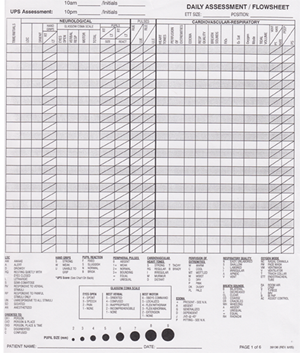Introduction
During her thirty years of experience as a nurse in intensive and palliative care, Terri Ulmer’s (a pseudonym) work had immersed her in a cascade of texts, including pain assessments, flowsheets, treatment records, nurses' notes, investigation narratives, medication records, and patient transfer forms. The flowsheet (see extract in Figure 1 below) Terri used to assess each of the patients under her care, for example, consisted of a six-page document for recording a patient’s vital signs, level of consciousness, input and output of fluids, and a range of key bodily systems: neurological, cardiovascular, respiratory, gastrointestinal, and hemodynamics. The final page is for “Nurses’ Progress Notes” to be “used only for changes in status [and] unusual situations.” Each patient assessment involved charting the patient’s bodily systems into the document’s 110 boxes using numbers or a variety of alphabetic codes.
Over a number of text-based interviews, Terri frequently mentioned the importance of the flowsheet, a document she filled out often on an hourly basis for every patient in the unit under her care. Explaining her use of the flowsheet during one of our earliest interviews, for example, Terri stated,
So you come in and your shift starts and you do an assessment and you assess the patient completely and you document it on the flowsheet—vital signs; if they had special equipment all the readings from that equipment go on here [pointing to the flowsheet]; their intake and output; heart rhythm and what it looks like; if they had drains, tubes; it all goes on here [pointing to the flowsheet]. You’ve got your criteria for the neurological assessment down here [pointing at the flowsheet] and that gets documented up here as well. You learn how to do your assessment according to the sheet so that you do it in the same order and it’s not difficult.
Her comments indicate how the flowsheet entrains her seeing of the patient, including which body systems she needs to attend to and even in what order.
According to Goodwin (1994), “The ability to see a meaningful event is not a transparent, psychological process but instead a socially situated activity accomplished through the deployment of a range of historically constituted discursive practices” (p. 606). Through acting with those practices, Goodwin noted, “a worker views the world from the perspective it establishes” (p. 609). Acting with the flowsheet is one of those discursive practices, and the result is a very “clinical” representation, or what Nicolas Dodier (1998) referred to as a “clinical framing,” of the persons under Terri's care (p. 74).
Terri’s use of the flowsheet, and the other documents she mentioned, to assess patients locates her in the densely textual landscape of the health care professional. And yet, like Charles, Kate, and Lindsey, it also locates her, and her seeing of patients as a nurse, along an extensive historical trajectory of literate activity that stretches through a number of other literate engagements. Terri’s seeing of patients as a health care professional also situates her across a capacious literate landscape that includes writing poetry, researching a science fiction novel, crafting an autobiographical memoir, participating in religious worship, and documenting her family’s history through photographs and storytelling. In this chapter, we partially trace Terri’s seeing of patients as it is semiotically remediated, a term we introduced in chapter 2 that addresses the semiotic transformation and re-use of representational practice, across those multiple streams of literate activity. Ultimately, we argue in this chapter that Terri’s seeing of patients is accomplished by a densely laminated assemblage of texts and textual activities. As in the previous chapters, the trajectory we trace argues for a more dispersed, complexly mediated, and heterogeneously situated understanding of literate activity and literate development.


